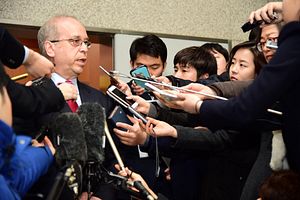Calls for a more robust U.S. policy toward China are heard whenever tensions run high on the Korean Peninsula. As North Korea’s biggest trading partner by far and one of the isolated regime’s only allies, it has long been acknowledged in the West that changing North Korean behavior, particularly its nuclear behavior, will only become possible through peaceful means when China becomes truly committed to that goal.
It should come as little surprise, then, that new measures designed to increase pressure on Beijing appear to be in the works. On September 28, Ambassador Daniel Fried, the State Department’s coordinator for sanctions policy, and Assistant Secretary of State for the Bureau of East Asian and Pacific Affairs Daniel R. Russel gave testimony before a Senate subcommittee that declared “global sanctions work is being compromised because of China’s economic relationship with North Korea” and was eager for more aggressive action. Fried indirectly admitted when pressed that a number of Chinese financial entities were under State Department investigation for potential ties to sanctioned North Korean businesses, and stated that “a change in China’s behavior is a prerequisite to a change in North Korea’s behavior.” Days before the committee hearing, Washington moved to sanction Dandong Hongxiang Industrial for business conducted with a North Korean bank accused of complicity with the regime’s nuclear and missile programs.
While the State Department officials asserted that “the trend line of China’s cooperation with the international community and its implementation efforts is improving,” the Obama administration has struggled to get China more fully on board with reigning in Pyongyang’s nuclear program. Even after the nuclear test conducted in January, which saw China back the toughest set of international sanctions yet against North Korea and agree to cargo inspections for everything moving in or out of the country, enforcement of penalties has remained an ongoing issue. This August, for example, saw a surge in North Korean exports through the Chinese city of Dandong, just across the Yalu River Bridge from North Korea. Chinese steel exports have also spiked in recent months.
The reasons for Beijing’s hesitancy to apply more pressure on its unpredictable ally on the Korean Peninsula, organized around a desire for regime stability, are well established. The theme that emerged from Fried and Russel’s testimony is that those reasons are no longer sufficient given the accelerated pace and intensity of the North Korean nuclear threat. Ultimately, the increased focus on China, across a variety of fronts, is a natural extension of thinking for U.S. policymakers. The extremely isolated DPRK economy has confronted Washington with the uncomfortable fact that the sanctions belt can only be tightened so much without an extra pull from Beijing. Both officials were pressed about potential new courses of action that would up the ante for China, from calls for the sanctioning of Chinese banks that handle DPRK funds to complete bans on Beijing’s importation of North Korean coal and iron ore (coal exports are one of Pyongyang’s single largest revenue generators).
Fried answered several times throughout the session that a new and updated United Nations Security Council Resolution (UNSCR) would likely be needed to implement these and other policy proposals, and gave a strong indication that is where things are headed for the administration. Fried went so far as to call the UNSCR process “the gold standard” for applying sanctions. UNSCR 2270 was passed in response to the January test earlier this year, and both Fried and Russel touted its successes while saying much more remained to be done.
Russel also suggested the timetable for deploying the U.S. Terminal High Altitude Area Defense (THAAD) system in South Korea had been moved up after the September 9 test. “Given the accelerating pace of North Korea’s missile tests, we intend to deploy on an accelerated basis. I would say as soon as possible,” Russel said when asked about the system.
THAAD, which has been slated for deployment in 2017, will add a strong additional layer to South Korea’s missile defense architecture. China, however, is decidedly unhappy with the system’s advanced radar capabilities, which range far enough to encompass parts of the Chinese mainland, and is even less thrilled with the prospect of deepened commitment to the U.S.-South Korean alliance.
Consternation in Beijing, however, was not enough to prevent the announcement of a THAAD battery deployment to the ROK in the wake of North Korea’s January nuclear test. The combination of its most recent detonation and the assortment of highly destabilizing ballistic missile tests Pyongyang has conducted throughout this year, including the firing of a KN-11 submarine-launched ballistic missile (SLBM) in August that has raised concerns of a potential second-strike capability, has cast light on the merits of sending a second THAAD system to the peninsula. Such a move would ensure more comprehensive coverage of South Korea and improve interceptor efficiency in the event of a saturation bombing style attack from the North. It would also send an unmistakable message to Beijing that the United States will not hesitate to send whatever weapons it deems necessary to defend its allies in the region, and that a greater Chinese commitment to sanctions enforcement is the only way to offset that.
Garth McLennan is a freelance writer and analyst with published work in 38 North, International Policy Digest, and Second Line of Defense: Delivering Capabilities to the Warfighter. He graduated from Arizona State University in 2015.

































